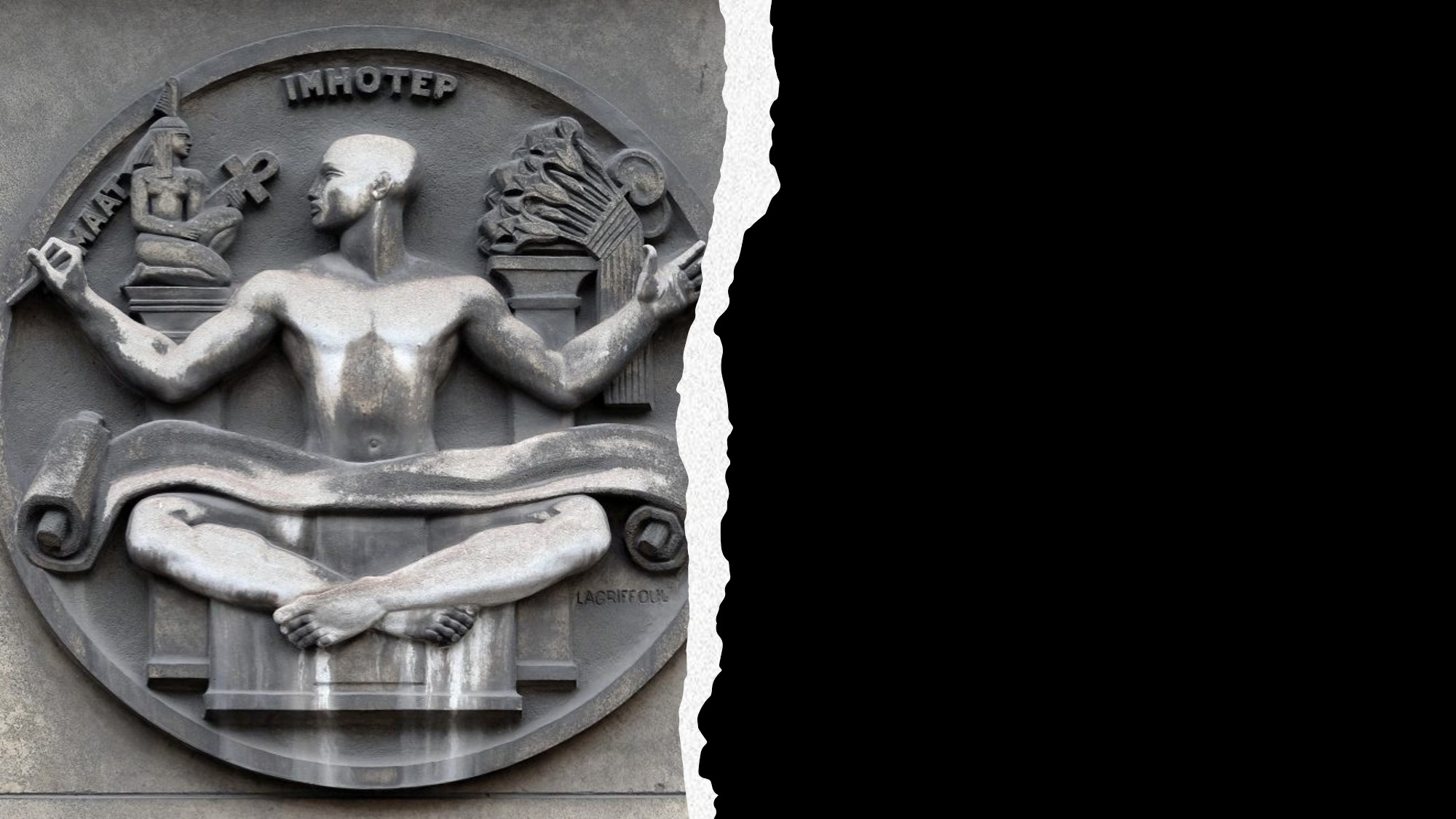- Jouanna, Jacques; Allies, Neil (2012), „Egyptian Medicine and Greek Medicine”, Greek Medicine from Hippocrates to Galen, Brill, , JSTOR 10.1163/j.ctt1w76vxr.6
- Said, Galal Zaki (17 November 2013). „Orthopaedics in the dawn of civilisation, practices in ancient Egypt”. International Orthopaedics. 38 (4) doi:10.1007/s00264-013-2183-z. ISSN 0341-2695. PMC 3971265. PMID 24240438.
- „Edwin Smith papyrus (Egyptian medical book)”. Encyclopedia Britannica (Online ed.). Retrieved 1 January 2016.
- Arab, Sameh M. „Medicine in Ancient Egypt – Part 1”. Arab World Books. Retrieved 18 November 2011.
- Fagan, Brian M. (2004). The Seventy Great Inventions of the Ancient World. Thames & Hudson. ISBN 978-0-50005130-6.
- WEINBERGER, B. (1946). FURTHER EVIDENCE THAT DENTISTRY WAS PRACTICED IN ANCIENT EGYPT, PHOENICIA AND GREECE. Bulletin of the History of Medicine,20(2).
- DAWSON, W. (1927). THE BEGINNINGS OF MEDICINE: MEDICINE AND SURGERY IN ANCIENT EGYPT. Science Progress in the Twentieth Century (1919–1933), 22(86).
- Griffith, F. Ll. (1898). The Petrie Papyri: Hieratic Papyri from Kahun and Gurob. London: Bernard Quaritch.
- Bynum, W. F.; Hardy, Anne; Jacyna, Stephen; Lawrence, Christopher; Tansey, E.M. (2006). „The Rise of Science in Medicine, 1850–1913”. The Western Medical Tradition: 1800–2000. Cambridge University Press. ISBN 978-0-521-47565-5.
- Dollinger, André. „The Kahun Gynaecological Papyrus”. An introduction to the history and culture of Pharaonic Egypt. Kibbutz Reshafim. Retrieved 21 April 2012.
- Dollinger, André (December 2002). „Ancient Egyptian Medicine”. An introduction to the history and culture of Pharaonic Egypt. Kibbutz Reshafim.
- Breasted, James Henry (1930). The Edwin Smith Papyrus. Chicago, Illinois: The University of Chicago Press.
- Allen, James P (2005). The Art of Medicine in Ancient Egypt. New York: The Metropolitan Museum of Art. ISBN 978-0-300-10728-9.
- Bryan, Cyril (1932). The Ebers Papyrus. New York: D. Appleton and Company.
- Nunn, John F. (1996). Ancient Egyptian Medicine. Transactions of the Medical Society of London. 113. Norman, Oklahoma: University of Oklahoma Press, ISBN 978-0-8061-2831-3. PMID 10326089.
- Ritner, Robert K. (April 2000). „Innovations and Adaptations in Ancient Egyptian Medicine”. Journal of Near Eastern Studies. 59 (2): doi:10.1086/468799. JSTOR 545610. PMID 16468204.
- Dollinger, André. „Herbal Medicine”. An introduction to the history and culture of Pharaonic Egypt. Kibbutz Reshafim. Retrieved 9 October 2015.
- Parkins, Michael D.; Szekrenyes, J. (March 2001). „Pharmacological Practices of Ancient Egypt” (PDF). Proceedings of the 10th Annual History of Medicine Days. Calgary, Alberta, Canada: The University of Calgary.
- „What progress did the Egyptians make in medical knowledge?”. Medicine Through Time: Model Questions and Answers. Passmores Academy. Archived from the original on 1 May 2008. Retrieved 1 January 2016.
- Magner, Lois (1992). A History of Medicine. Boca Raton, Florida: CRC Press. ISBN 978-0-8247-8673-1.
- Stiefel, Marc; Shaner, Arlene; Schaefer, Steven D. (February 2006). „The Edwin Smith Papyrus: The Birth of Analytical Thinking in Medicine and Otolaryngology”. The Laryngoscope. 116 (2): doi:10.1097/01.mlg.0000191461.08542.a3. ISSN 0023-852X.
- El-Aref, Nevine (December 2006). „Too big for a coffin”. Al-Ahram Weekly. Cairo, Egypt: Al-Ahram. Archived from the original on 18 November 2014. Retrieved 1 January 2016.
- Hawass, Zahi (2003). „The tomb of the physician Qar”. Hidden Treasures of the Egyptian Museum: One Hundred Masterpieces from the Centennial Exhibition (Supreme Council of Antiquities ed.). Cairo, Egypt: American University in Cairo Press. ISBN 978-977424778-1.
- Lauer, Jean Philippe (3 January 2013). „Imhoteb Museum”. Egypt Tourism News. Egypt Tourism Board. Retrieved 1 January 2016.
- Jackson, Russell (6 December 2006). „Mummy of ancient doctor comes to light”. The Scotsman. Edinburgh. Retrieved 24 March 2011.
- Greiner, Ryan (2001). „Ancient Egyptian Medicine”. Creighton University Virtual Museums. Creighton University. Retrieved 2 April 2011.
- Herodotus (25 February 2006) [First published 1890]. An Account of Egypt (from The History of Herodotus Translated into English, Vol. I, Pages 115–208). Translated by Macaulay, G. C. Project Gutenberg.
- Arab, Sameh M. „Medicine in Ancient Egypt – Part 3”. Arab World Books. Retrieved 18 November 2011.
- „Medicine in Ancient Egypt”, SpringerReference, Springer-Verlag, doi:10.1007/springerreference_78530
- Gordan, Andrew H.; Shwabe, Calvin W. (2004). The Quick and the Dead: Biomedical Theory in Ancient Egypt. Egyptological Memoirs. Leiden: Brill Academic Publishers. p. 154. ISBN 978-90-04-12391-5.
- Grajetzki, Wolfram; Quirke, Stephen (2003). „Knowledge and production: the House of Life”. Digital Egypt for Universities. University College London. Retrieved 18 November 2011.
- Bareš, Ladislav (2005). „The Shaft Tomb of Udjahorresnet”. Czech Institute of Egyptology. Charles University in Prague. Retrieved 1 January 2016.
- Wood, Gemma Ellen (4 July 2012). „Dispelling the myth – Herodotus, Cambyses, and Egyptian religion #1”. The Egyptiana Emporium. Retrieved 1 January 2016.
- Agut-Labordère, Damien (2013). „The Saite Period: The Emergence of a Mediterranean Power”. Ancient Egyptian Administration. Handbook of Oriental Studies. Leiden: Brill Academic Publishers. pp. 965–1027. ISBN 978-90-04-24952-3.
- „Wedjahor-Resne”. Livius.org. Jona Lendering. 22 August 2015. Retrieved 1 January 2016.
- Fonahn, Adolf (1 January 1909). „Der altägyptische Arzt Iwti”. Archiv für Geschichte der Medizin. 2 (5): JSTOR 20772830.
LITERATURA PRZEDMIOTU – EGIPT

